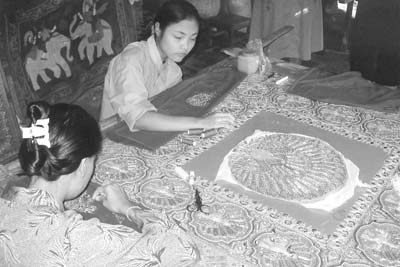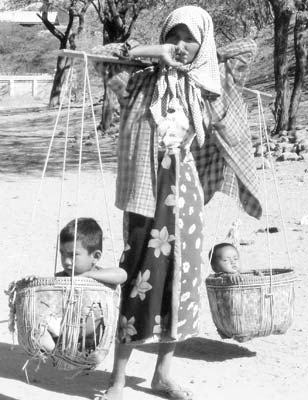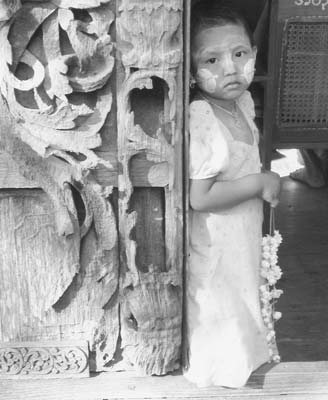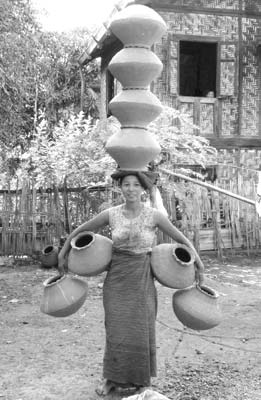Myanmar — Experiencing a people and their crafts
by Jane L. Reber, Palo Alto, CA
I had such significant doubts that I would ever travel to Myanmar (Burma) because of its repressive government that when I found a group that assured me the moneys paid would go to the people and not the government, I signed on. I booked with Craft World Tours of Byron, New York.
The focus of the tour was visiting craftspeople and their villages, going “behind the wall,” as it were, to meet the locals. Our small group consisted of craftspeople, teachers and buyers, and the prevailing sentiment was to encourage tourism to this region so that the government will gain an open attitude. Everywhere we went we were greeted with smiles and warm welcomes.
A bit of brilliance
Our January-February ’06 tour began in Los Angeles with a long flight to Bangkok, where we stayed overnight at the very convenient Amari Airport Hotel connected to the airport.
This first-class hotel has many restaurants, services and, best of all, trolleys to take your luggage to and from the airport. We had checked our luggage through to Yangon, so it was easy to get to the plane the next day.
Yangon (formerly Rangoon), the one-time capital city of Myanmar, has all the hustle and bustle and traffic of every major city. We stayed at the super-deluxe Grand Plaza Parkroyal Hotel, where we were greeted by hotel doormen dressed in colorful ethnic clothes.
The most famous sight of Yangon is the Shwedagon Pagoda, a giant stupa in a complex of temples and other pagodas all covered in gold — a brilliant sight in the late afternoon. It was crowded with people venerating the many statues of Buddha that could be found in the shrines which surrounded the main stupa, said to contain relics of Buddha.
The next day, we relaxed on a sunset cruise on the Yangon River — interesting for the boat as well as the sights. The riverboat looked like a rusty bucket, and we sat on the upper deck on movable plastic patio chairs watching the action on the river. There were many people in water taxis put-putting across the wide brown river, and I saw people fishing from boats. The sunset was brilliant!
Inle Lake
On an internal flight the next day, we went to Heho, the tiny airport near Inle Lake. While waiting for my flight, I felt like I had stepped back into the 1950s. We waited until our flight was “called,” then went through security into a room of rigid rows of orange plastic seats, where our wait continued. When it was time to board, the announcement came on a whiteboard carried through the room by an official so everyone could see. We walked to the plane and soon took off.
When we got to the Hu Pin Hotel, we were joyously greeted by a band of musicians with cymbals and drums and a big red banner. After getting settled, we left for a boat ride on Inle Lake. We saw houses on stilts, colorful laundry, people washing utensils and clothes in the lake, and men fishing.
There are many man-made “islands” in the lake created from soil piled atop water hyacinths, which otherwise would clog the waterways. These islands, which take years to make and are held in place with long bamboo poles, are floating vegetable and flower gardens.
In the huge market at the other end of the lake we had an hour, which I used to buy interesting crafts.
We made a stop on the lake at a weaving factory to see how ikat weaving is done and how the thread is dyed. As one of the women was pulling “thread” out of lotus stems, she showed us how strong it was.
Local interaction
We continued on to Mandalay, where the world’s largest book can be found at Kuthodaw Paya. Here, a series of whitewashed stupas each contains a marble slab on which is carved a page from the writings of Buddha. There are hundreds of stupas, and it is said that it takes eight years to read it all!
Then it was off to see the famous sunset of Mandalay. The truck ride up the mountain was a challenge. The driver of the ancient, decrepit vehicle at first couldn’t get it started. When he did, it leapt to life and we chugged up the hill’s hairpin turns. Our descent in the dark was even hairier, as the driver used the headlights very sparingly.
The next day’s craft visits included a gold-leaf factory, where the men hammering large gold pieces with heavy mallets made a percussive symphony, and a small factory where the sequins used to create intricate kalagas (wall hangings) are made.
During our visit to a pottery village, I saw thousands of pots arranged in a gigantic circle about six feet high. Men were placing straw over and between the pots, readying them for the firing. One woman showed us how designs are worked into the clay by gently pounding with a paddle with a pattern on it, and another woman amazingly lifted four pots to her head, carrying two more in each hand.
Cruising to Bagan
Our tour included a cruise on the vast Irrawaddy River and I loved it. The elegant polished teak and brass on board were definitely “old world”; still, the cabins were very comfortable. Rattan chairs lined the deck, where we could just sit and watch the river.
The river is one of Myanmar’s major waterways, and the riverboat stopped each day to visit a different village. The cruise ended at Bagan (Pagan), and even before we got there the hundreds of pagodas and temples were visible, the golden spires glittering in the sunlight.
The architecture of the temples and pagodas of Bagan combine Hindu and Buddhist styles. The brickwork on the buildings was incredibly beautiful, and it was a wonder how they could have been created using the limited tools available.
Great flaming arches of convoluted brick face many of the structures, and at the tops are terraces for viewing sunsets and the other temples which crowd the plain.
Craft World Tours (6776 Warboys Rd., Byron, NY 14422; 585/548-2667, www.craftworldtours.com) offers many craft tours to Eastern Europe and Asia, and the tours include many extras. Their main focus is to meet the local people and see their work.
Our guide in Myanmar was Aye-Aye Hnynn Steinhardt, who was born, brought up and educated in Myanmar and studied English at the Institute of Education in Yangon. She was a delight!
The cost of my 19-day “Myanmar: Temples, Pagodas & Timeless Ways” tour was $4,526 per person (plus airport taxes), including air from Los Angeles.





